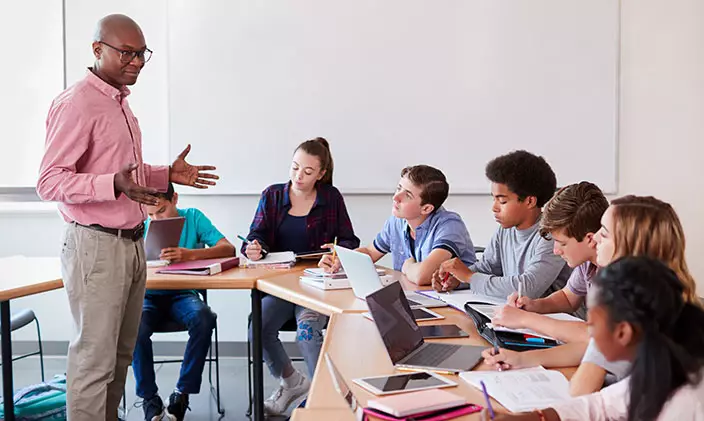A Simple Explanation of School Violence and Why Bandura’s Learning Theory May Be the Answer

Our nation’s schools should be safe havens. However, parents, students, and school staff feel unsafe, and the data supports those concerns. The Institute of Education Sciences (2022) reported rising bullying, hate crimes, physical attacks, and threats to teachers and students after returning to face-to-face instruction following the first wave of the COVID-19 pandemic. It has been established that during the isolation period of the pandemic, domestic and societal violence increased at alarming rates (Boserup et al., 2020). Child abuse and victims of domestic aggression were trapped at home with an aggressor (Piquero et al., 2021), leaving the young without adequate role models to observe and imitate. Bandura and Walters (1977) explained behavior through three processes: Modeling, observation, and imitation. Hence, the rise of violence in our schools can be explained through Bandura’s Learning theory.
Bandura’s Learning Theory and Role Models
Society implements a behaviorist approach to correct errors. However, Bandura and Walters (1977) contended that relying solely on a reward/punishment system to obtain a desired behavior is counterproductive. Furthermore, Bandura explained that modifying behavior requires competent social models to observe and imitate. In other words, social learning can be positively impacted if adequate role models are available.
One problem is that children are exposed to multiple models: teachers, parents, prestigious community members, idols on television (Bandura & Walters, 1977), and influencers on the Internet and social media. Hence young people learn the good, the bad, and the ugly by observing and imitating these role models. According to Ahn et al. (2020), role models significantly impact people’s actions as they exemplify behaviors and goals. Therefore, school leaders must understand and create a plan to assist young people in the process of unlearning patterns of violence through adequate models.
Building Safer Schools with the Help of Positive Role Models
Helping children identify positive role models requires consistency and thoughtful planning. Schools, parents, and leaders should include the topic of role models in daily conversations with children in formal and informal contexts. For example, literacy instruction, especially fiction, is an excellent opportunity to establish positive character traits worthy of emulation. In addition, it is essential to include examples of people using proper conflict resolution in real life while modeling the behavior daily. Exemplary community members, such as sports and music celebrities and guest speakers, may positively influence negative patterns of conduct. Furthermore, children showing patterns of aggression at an early age should be exposed to community members willing to connect with and support these children. Life is imperfect, and people will make mistakes; however, teaching our children the value of apologies and reflection is a powerful tool.
Building relationships with children and parenting is essential as they imitate the behavior of people they feel connected with. However, a healthy relationship is sometimes mistaken for a friendship without boundaries, and therefore, the adult becomes permissive using a high responsiveness and low demandingness style (Lo et al., 2020). According to Lo et al. (2020), depriving children of autonomy or providing unlimited autonomy negatively impacts children’s mental health. Hence, children may develop undesired behaviors.
Technology and social media have benefits, but how can we properly use these tools to be role models for our children? Research is needed to learn more about technology and its impact on the human brain. However, studies have revealed that the Internet can be addictive and a source of violence for our children (Lo et al., 2020). While society adapts and discovers solutions to these problems, schools should incorporate technology classes orienting the young on how to navigate the Internet and avoid aggression, bullying, and ridicule. Parents should also be educated and held accountable for their children’s social media and Internet behavior.
Human behavior is complex, and researchers are always intrigued by it. While the concept of role models is not new and has been linked to behavioral outcomes in many studies, sometimes it is crucial to go back to the basics and adjust the course of action as other interventions are needed to transform behaviors in our educational institutions. All in all, Bandura’s Learning theory may be a starting point for safer schools in America.
References
Ahn, J. N., Hu, D., & Vega, M. (2020). “Do as I do, not as I say”: Using social learning theory to unpack the impact of role models on students’ outcomes in education. Social and Personality Psychology Compass, 14(2), e12517. https://doi.org/10.1111/spc3.12517
Bandura, A., & Walters, R. H. (1977). Social learning theory. Prentice Hall
Boserup, B., McKenney, M., & Elkbuli, A. (2020). Alarming trends in US domestic violence during the COVID-19 pandemic. The American Journal of Emergency Medicine, 38(12), 2753–2755. https://doi.org/10.1016/j.ajem.2020.04.077
Institute of Education Sciences (2022). School pulse panel. https://ies.ed.gov/schoolsurvey/spp/
Lo, B. C. Y., Lai, R. N. M., Ng, T. K., & Wang, H. (2020). Worry and permissive parenting in association with the development of internet addiction in children. International Journal of Environmental Research and Public Health, 17(21), 7722. https://doi.org/10.3390/ijerph17217722

ABOUT THE AUTHOR
Juana Lang, Ed.D.
Juana has been an educator for 26 years. During this time, she served in different roles and graduated from the University of Phoenix with a Doctor of Education degree in September 2022.